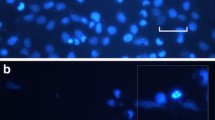Abstract
Selenium is a cellular growth inhibitor in many mammary tumor cells. To comprehend the mechanism for the selenium-induced cell death, we examined the effects of sodium selenite, which has been one of the most extensively investigated selenium compounds, in human hepatoma Hep G2 cells.
Cell viability gradually decreased after treatment with sodium selenite within the concentration range of 10–50 µM. Low (10 µM) selenite has shown a high-percentage laddering pattern compared to the high (25 µM) cytotoxic selenium concentration in agarose gel electrophoresis. G2M-phase enrichment was also concentration dependent. The most consistent transmission electron microscopic finding was the existence of large lysosomes.
Based on these data, we hypothesize that sodium selenite predominantly shows its apoptotic effect over hydrogen selenite accumulation.
Similar content being viewed by others
References
J. Lu, C. Jiang, M. Kaeck, et al., Dissociation of the genotoxic and growth inhibition effects of selenium, Biochem. Pharmacol. 50, 213–219 (1995).
D. Medina and D. G. Morrison, Current ideas on selenium as a chemoprevent agent, Pathol. Immunopathol. Res. 7, 187–199 (1988).
J. Lu, M. Kaeck, C. Jiang, et al., Selenite induction of DNA strand breaks and apoptosis in mouse leukemic L1210 cells, Biochem. Pharmacol. 47, 1531–1535 (1994).
H. M. Shen, C. F. Yang, and C. N. Ong, Sodium selenite-induced oxidative stress and apoptosis in human hepatoma HepG2 cells, Int. J. Cancer 81, 820–828 (1999).
M. S. Stewart, R. L. Davis, L. P. Walsh, et al., Induction of differentiation and apoptosis by sodium selenite in human colonic carcinoma cells (HT29), Cancer Lett. 117, 35–40 (1997).
H. J. Thompson, A. Wilson, J. Lu, et al., Comparison of the effects of an organic and an inorganic form of selenium on a mammary carcinoma cell line, Carcinogenesis 15, 183–186 (1994).
D. T. Vistica, P. Skehan, D. Scudiero, et al., Tetrazolium-based assays for cellular viability: a critical examination of selected parameters affecting formazan production, Cancer Res. 51, 2515–2520 (1991).
M. F. McCartly, Selenium, calcium channel blockers, and cancer-risk—the yin and yang of apoptosis, Med. Hypotheses 50, 423–433 (1998).
Z. Darzynkiewicz, G. Juan, X. Li, et al., Cytometry in cell necrobiology: analysis of apoptosis and accidental cell death (necrosis), Cytometry 27, 1–20 (1997).
C. Jiang, W. Jiang, C. Ip, et al., Selenium-induced inhibition of angiogenesis in mammary cancer at chemopreventive levels of intake, Mol. Carcinogen. 26, 213–225 (1999).
S. Y. Yu, P. Ao, L. M. Wang, et al., Biochemical and cellular aspects of the anticancer activity of selenium, Biol. Trace Element Res. 15, 243–255 (1988).
G. F. Combs, Jr, Chemopreventive mechanism of selenium, Med. Klin. 15, 94(Suppl. 3), 18–24 (1999).
C. Ip, Lessons from basic research in selenium and cancer prevention, J. Nutr. 128, 1845–1854 (1998).
K. A. Poirer and J. A. Milner, The effect of various seleno-compounds on Erlich ascites tumor cells, Biol. Trace Element Res. 1, 25–34 (1979).
C. Ip, C. Hayes, R. Budnick, et al., Chemical form of selenium, critical metabolites and cancer prevention, Cancer Res. 51, 595–600 (1991).
K. Ortman and B. Pehrson, Effect of selenate as a feed supplement to dairy cows in comparison to selenite and selenium yeast, J. Anim. Sci. 77, 3365–3370 (1999).
J. W. Finley, C. D. Davis, and Y. Feng, Selenium from high selenium broccoli protects rats from colon cancer, J. Nutr. 130, 2384–2389 (2000).
D. Y. Cho, U. Jung, and A. S. Chung, Induction of apoptosis by selenite and selenodiglutathione in HL-60 cells: correlation with cytotoxicity, Biochem. Mol. Biol. Int. 47, 781–793 (1999).
J. G. Ren, R. L. Zheng, Y. M. Shi, et al., The possible mechanism of the differentiation and apoptosis induced by oxidative stress may be related to the lipid peroxidation of cell membrane. Cell. Biol. Int. 22, 41–49 (1998).
H. E. Ganther and C. Corcoran, Selenotrisulfides. II. Cross-linking of reduced pancreatic ribonuclease with selenium, Biochemistry 8, 2557–2563 (1969).
F. Islam, Y. Watanabe, H. Morii, et al., Inhibition of rat brain prostaglandin D synthase by inorganic selenocompounds, Arch. Biochem. Biophys. 289, 161–166 (1991).
S. Lopez, Y. Miyashita, and S. S. Simons, Jr, Structurally based, selective interaction of arsenite with steroid receptors, J. Biol. Chem. 265, 16,039–16,042 (1990).
G. D. Frenkel, A. Walcott, and C. Middleton, Inhibition of RNA and DNA polymerases by the product of the reaction of selenite with sulfhydryl compounds, Mol. Pharmacol. 31, 112–116 (1987).
L. N. Vernie, J. G. Collard, A. P. Eker, et al., Studies on the inhibition of protein synthesis by selenodiglutathione, Biochem. J. 180, 213–218 (1979).
H. E. Gantner, Selenium metabolism, selenoproteins and mechanisms of cancer prevention: complexities with thioredoxin reductase, Carcinogenesis 20, 1647–1666 (1999).
H. E. Ganther, Pathways of selenium metabolism including respiratory excretory products, J. Am. Coll. Toxicol. 5, 1–5 (1986).
R. A. Sunde, Molecular biology of selenoproteins, Annu. Rev. Nutr. 10, 451–474 (1990).
C. J. Sherr, Cancer cell cycles, Science 274, 1672–1677 (1996).
H. S. Park, S. H. Huh, Y. Kim, et al., Selenite negatively regulates caspase-3 through a redox mechanism, J. Biol. Chem. 275, 8487–8491 (2000).
R. Sinha and D. Medina, Inhibition of cdk2 kinase activity by methylselenocysteine in synchronized mouse mammary epithelial tumor cells, Carcinogenesis 18, 1541–1547 (1997).
Author information
Authors and Affiliations
Rights and permissions
About this article
Cite this article
Celik, H.A., Aydin, H.H., Deveci, R. et al. Biochemical and morphological characteristics of selenite-induced apoptosis in human hepatoma hep G2 cells. Biol Trace Elem Res 99, 27–39 (2004). https://doi.org/10.1385/BTER:99:1-3:027
Received:
Revised:
Accepted:
Issue Date:
DOI: https://doi.org/10.1385/BTER:99:1-3:027




